Steamtown, U.S.A.
|
Meadow River Lumber Company Shay #1 on static display at Steamtown, Bellows Falls, Vermont, ca. 1974 | |
| Established | 1964 |
|---|---|
| Dissolved | 1983 |
| Location | Bellows Falls, Vermont |
| Coordinates | 43°9′42″N 72°27′13″W / 43.16167°N 72.45361°WCoordinates: 43°9′42″N 72°27′13″W / 43.16167°N 72.45361°W |
| Type | Steam locomotive and other rail equipment |
Steamtown, U.S.A., was a steam locomotive museum that ran steam excursions out of North Walpole, New Hampshire, and Bellows Falls, Vermont, from the 1960s to 1983. The museum was founded by millionaire seafood industrialist F. Nelson Blount. The non-profit Steamtown Foundation took over operations following his death in 1967. Because of Vermont's air quality regulations restricting steam excursions, declining visitor attendance, and disputes over the use of track, some pieces of the collection were relocated to Scranton, Pennsylvania, in the mid-1980s and the rest were auctioned off. After the move, Steamtown continued to operate in Scranton but failed to attract the expected 200,000–400,000 visitors. Within two years the tourist attraction was facing bankruptcy, and more pieces of the collection were sold to pay off debt.
In 1986, the United States House of Representatives, under the urging of Pennsylvania Representative Joseph M. McDade, voted to approve $8 million to study the collection and to begin the process of making it a National Historic Site. As a result, the National Park Service (NPS) conducted historical research on the equipment that remained in the Foundation's possession. This research was used as a Scope of Collections Statement for the Steamtown National Historic Site. The scope was published in 1991 under the title Steamtown Special History Study. The report provided concise histories of each piece of equipment and made recommendations as to whether or not each piece belonged in the soon-to-be government-funded collection.
By 1995, Steamtown had been acquired and developed by the NPS with a $66 million allocation. Several more pieces have been removed from the collection as a result of the government acquisition. Part of the Blount collection is still on display at the Steamtown National Historic Site in Scranton.
History
Formation of the collection
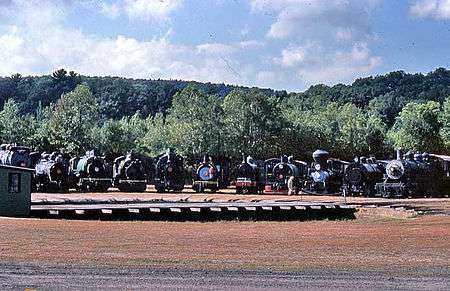
F. Nelson Blount, the heir to the largest seafood processor in the United States, was an avid railroad enthusiast. When he was just seventeen years old he wrote a book on steam power. Acquiring the narrow-gauge Edaville Railroad in Carver, Massachusetts in 1955, he began amassing one of the largest collections of antique steam locomotives in the United States. By 1964, another part of his collection housed at North Walpole, New Hampshire consisted of 25 steam locomotives from the United States and Canada, 10 other locomotives, and 25 pieces of rolling stock. The Monadnock, Steamtown & Northern Railroad, as the enterprise was then called, ran excursions between Keene and Westmoreland, New Hampshire. In addition to Edaville Railroad and Steamtown, Blount also ran excursions at Pleasure Island in Wakefield, Massachusetts and Freedomland U.S.A. in New York City. In the early 1960s, Blount came close to entering into an agreement with the state of New Hampshire in which he would donate 20 locomotives to a museum which was to be located in Keene. However, the plan, which was originally approved by New Hampshire governor Wesley Powell, in 1962, was later rejected by the new governor, John W. King.[1][2] An advisory committee had said of the proposed plan, that it "does not take advantage of anything that is singularly and peculiarly New Hampshire."[3]
In 1964, incorporation papers were filed for the "Steamtown Foundation for the Preservation of Steam and Railroad Americana". The non-profit charitable, educational organization was to have nine non-salaried directors, including the five incorporators of which Blount was one. The other incorporators were former New Hampshire governor, Lane Dwinell; Emile Bussiere; Robert L. Mallat, Jr., mayor of Keene; and Bellows Falls Municipal Judge, Thomas P. Salmon, who later became governor of Vermont. The president of the Campbell Soup Company, William B. Murphy, who had also served as National Chairman of Radio Free Europe, and Fredrick Richardson, then vice president of Blount Seafood, were among the other directors. The first order of business for the Steamtown Foundation was to acquire the Blount collection at North Walpole, and relocate it to property once owned by the Rutland Railroad, in Bellows Falls, Vermont.[1]
Steamtown in Vermont
F. Nelson Blount was killed when his private airplane hit a tree during an emergency landing, in Marlboro, New Hampshire, on August 31, 1967.[4] By that time a good deal of Blount's collection was controlled by the Steamtown Foundation and had been relocated to Bellows Falls. Blount owned several corporations and one, the Green Mountain Railroad (GMRC), controlled the tracks that lay between Walpole, Bellows Falls and Chester, Vermont, which Steamtown was to use for its excursions.[5] When Blount died most of the controlling stock of the GMRC was transferred to the president of the railroad, Robert Adams.[6]

Throughout its tenure in Vermont, Steamtown provided several types of excursions, primarily in the summer and during the peak foliage season of the autumn. Occasionally, these trips would be lengthy, like one that ran from Boston to Montreal, or those that ran between Bellows Falls and Rutland, Vermont. On a daily basis the excursions ran from Riverside station in Bellows Falls to Chester depot. The cost of the trip, which in 1977 was $5.75 for an adult and $2.95 for a child, was combined with entrance into the museum, which was the grounds of Riverside station.[7] The station was located about 2 miles (3 km) outside of town and was situated on the bank of the Connecticut River. One newspaper travel writer, Bill Rice, described the 13 miles (21 km) trip from Riverside to Chester: "The trip to Chester affords a beautiful view of unspoiled Vermont countryside-covered bridges, vintage farms with grazing livestock and cornfield and a winding river with a deep gorge and picturesque waterfall."[7] The river that Rice referred to was the Williams River, which crossed the route of the train seven times. The waterfall was at Brockway Mills Gorge and was seen from a bridge 100 feet (30 m) above the gorge. Rice also said that at the time he was writing, 1977, Steamtown had the largest collection of steam locomotives in the world.[7]
In 1971, the Board of Health of Vermont issued a waiver to the GMRC for Vermont's air pollution regulations. The waiver permitted the operation of steam locomotive excursions between Steamtown's Riverside station at Bellows Falls, and Chester depot.[8] In 1974, as the state of Vermont prepared for its celebration of the country's bicentenary, in which the Steamtown excursion featured prominently, the subject of the air pollution regulations came up again. The tourist attraction was operating on temporary permits that allowed it to operate excursions in Vermont.[9] By 1976, the relationship between Steamtown and GMRC deteriorated as the two organizations fought over maintenance of the tracks, which were owned by the state of Vermont.[10]
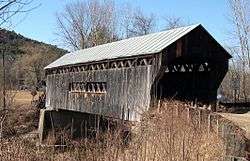
By 1978, the Steamtown Foundation had begun scouting for a new location for Steamtown, U.S.A. Orlando and perhaps other locations in Florida were under consideration.[11] In 1980, Ray Holland, the Chairman of the Board of Steamtown Foundation, resigned after accusing the board of incompetence. His resignation was followed by that of Robert Barbera, a long-time director of the board.[12] In the year that followed, Steamtown did not run excursions. Don Ball, Jr., had taken over direction of Steamtown by this time and discovered that the excursion train did not meet federal safety guidelines. In 1981, despite its vast holdings of vintage railroad stock, Steamtown, U.S.A. had only 17,000 visitors, while Connecticut's Essex Valley Railroad, which ran two small engines, had 139,000 visitors.[13] Even in its best year, 1973, the Vermont location had attracted only 65,000 visitors.[14]
Self-syndicated newspaper columnist Michael McManus once said that his goal in writing his weekly column was "to suggest answers to problems of the old industrial states."[15] In March 1982 a substantial article by McManus appeared in the Bangor Daily News. In the article, McManus proposed several reasons why a city, like Chicago, Pittsburgh, or Scranton might find the addition of a tourist attraction like Steamtown beneficial. McManus went on to explain why the business was failing in Vermont. Among the reasons the article gave for poor attendance at the Vermont site were: past failed management, an isolated location and the lack of signs on Interstate 91, which the state opposed.[13] In addition to these problems, the roof of the largest storage shed on the site collapsed under heavy snow the previous winter, damaging several pieces of equipment.[13] Among the injured were the Canadian Pacific Railway No. 1293[16] and the Meadow River Lumber Company No. 1 Shay (shown in the infobox).[17]
When asked by McManus to describe the value of the Steamtown collection, Jim Boyd, editor of Railfan magazine said, "Everything there is no longer obtainable anywhere, whether it is the "Big Boy" Union Pacific No. 4012 or the Rahway Valley No. 15, a nice-sized locomotive any museum would give a right arm for. Most of the other large collections do not have any serviceable equipment."[13] McManus closed his argument for the relocation of Steamtown by pointing out, "What is at stake is more than tourism and jobs. It is a significant part of America's past before the welder's torch is turned on the likes of the 1877 "Prince of Liege", the rare Union Pacific diamond stack, etc. The steel alone is worth $3 million.[13]
In June 1983, McManus wrote about Steamtown again, this time announcing that Scranton had taken his suggestion. He said that other cities in contention for the relocation were Springfield, Massachusetts, and Willimantic, Connecticut. "But on May 24, Scranton signed a contract to get it, pledging to raise $2 million to cover the cost of moving 40 ancient steam engines and 60 cars, few of which are operable, and to create a museum."[15] Steamtown sponsored its last Vermont excursion on October 23, 1983, using Canadian Pacific 1246 to pull a "dozen or so cars" on a 100 miles (160 km) round trip from Riverside station to Ludlow, Vermont.[18]
Steamtown in Scranton and nationalization
When Scranton agreed to take on Steamtown, U.S.A., it was estimated that the museum and excursion business would attract 200,000 to 400,000 visitors to the city every year.[19] In anticipation of this economic boon, the city and a private developer spent $13 million to renovate the Delaware, Lackawanna and Western Railroad (DL&W) station and transform it into a Hilton hotel, at a time when the unemployment rate in the city was 13 percent.[20] Only 60,000 visitors showed up at Steamtown in 1987, and the 1988 excursions were canceled. After only three years, it was $2.2 million in debt[21] and facing bankruptcy.[22][23] Part of the problem was the cost of restoration of the new property and the deteriorating equipment. In addition, while the tourists in Vermont had enjoyed the sights of cornfields, farms, covered bridges, a waterfall and a gorge on a Steamtown excursion,[7] the Scranton trip to Moscow, Pennsylvania, cut through one of the nation's largest junkyards, an eyesore described by Ralph Nader as "the eighth wonder of the world".[24]
In 1986, the U.S. House of Representatives, under the urging of Scranton native, Representative Joseph M. McDade,[23] voted to approve the spending of $8 million to study the collection and to begin the process of making it a National Historic Site.[25] By 1995, Steamtown was acquired and developed by the National Park Service (NPS) at a total cost of $66 million,[21][23] and opened as Steamtown National Historic Site the same year. In preparation for its acquisition of the collection, the NPS had conducted historical research during 1987 and 1988 on the equipment that still remained in the foundation's possession. This research was used for a Scope of Collections Statement for Steamtown National Historic Site and was published in 1991 under the title Steamtown Special History Study. Aside from providing concise histories of the equipment, the report also made recommendations as to whether or not each piece belonged in the now government-funded collection.[26] Historical significance to the United States was a criterion of the recommendations.[27] Many of the pieces of equipment that did not meet the report's recommendations were sold or traded[28] for pieces that had historical significance to the DL&W grounds on which the site is located.[29]
The collection
Before its move to Scranton, Steamtown, U.S.A. sold several pieces of the collection. After the facility was nationalized, several other pieces were sold or traded for pieces that were significant to the Scranton area.[28][29] Some examples of the original collection are profiled below. In some cases, the pieces of equipment discussed here are still in the collection in Scranton, but several others are not. When possible the most recent information on the location of the equipment is provided.
In operation at Bellows Falls
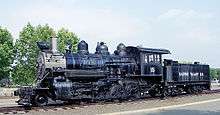
Rahway Valley No. 15 was built by Baldwin Locomotive Works, June 1916. It is a 2-8-0 Consolidation type locomotive. It was built for Oneida & Western Railroad and wore the number 20 for that company. The railroad's initial purpose was to develop Tennessee's coal and lumber industry, but it became a short line that connected the Cincinnati, New Orleans and the Texas Pacific Railways between Oneida and Jamestown, Tennessee.[27]
In the mid-1930s the engine was purchased by Rahway Valley Railroad in New Jersey. Renumbered 15, the locomotive served primarily while the company's other locomotives were being serviced. The locomotive was the favorite of master mechanic Charles Nees. "Perhaps not the most efficient engine, Rahway Valley No. 15 qualified as the line's most attractive."[27] When it was retired in 1953, having been replaced with diesel power, No. 15 was put into well-protected storage until it was purchased by F. Nelson Blount in 1959.[27]
Blount used No. 15 first for a static display at Pleasure Island, and then for excursions in New Hampshire and Vermont from 1962 to 1967. It was used again at Steamtown, in 1973, when it blew a flue while heading a triple header excursion from Riverside. The incident left veteran engineer Andy Barbera scalded and No. 15 in need of repair. Since the services of the locomotive were not needed at the time, the repairs were not done and remained undone by the time the Steamtown Special History was written. While in Blount's possession, the locomotive appeared in the movie The Cardinal (1963). The Steamtown Special History Study recommended that the engine be cosmetically and operationally restored, as it had served in the northeastern quarter of the United States and had been serviced, at least once, at the Lackawanna's Scranton shop.[27] As of March 2012, the locomotive is still displayed at Steamtown National Historic Site.[30]
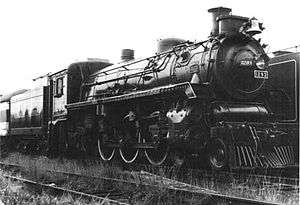
Canadian Pacific Railway No. 1293 was built in 1948 by Canadian Locomotive Company. It was retired after only eight years of service when diesel power made it obsolete.[31] This was one of three type 4-6-2, class G5d light-weight "Pacific" model locomotives that were operational at the time that Steamtown was in Bellows Falls. The Steamtown Special History Study gave no details of the operational career of 1293, but said that Blount purchased it under the name of Green Mountain Railroad, in January 1964. The Steamtown Foundation purchased the locomotive from Green Mountain Railroad in 1973 and rebuilt it in 1976. Making its debut as an excursion train in June of that year and sporting a green and black color scheme, 1293 served the state of Vermont as its "Bicentennial Train", logging 13,000 miles (21,000 km).[16] Leased by the state of Vermont for 80 miles (100 km) excursions that were scheduled for the entire year, the engine was dubbed "The Spirit of Ethan Allen".[32] In 1979, the locomotive was renumbered "1881", painted black with silver stripes, and leased to a Hollywood company for use in the filming of the horror movie Terror Train (1979), starring Jamie Lee Curtis. In 1980, the locomotive was repainted with a color scheme used by Canadian Pacific in the 1930s. The black, gold, and Tuscan red paint job was popular with railroad enthusiasts and photographers. The number 1293 was also restored to the engine. In February 1982, the headlights, handrails, and cab roof of 1293 were damaged when the roof of a Steamtown storage building gave way to heavy snow.[16]
Although the Steamtown Special History Study reasoned that, since this type of locomotive had historically operated in New England, perhaps as far south as Boston, it qualified to be part of the federal government's collection,[16] the Canadian native sat unused for 12 years following the move to Scranton.[33][34] Ohio Central Railroad System purchased it in 1996, and it underwent a 13-month restoration. As of July 2010, Ohio Central Railroad has lost control of most of its holdings, but former owner, Jerry Joe Jacobson, maintained a collection of vintage equipment including CPR 1293 and her sister, CRP 1278, which is also a veteran of Steamtown, U.S.A. operational locomotives. No. 1293 is still operational as of October 2011.[33][34][35]
Canadian Pacific Railway No. 1278, like her sister, CPR 1293, CPR 1278 was also built by Canadian Locomotive Company in 1948, and is a type 4-6-2, class G5d light-weight "Pacific" locomotive. It was purchased by Blount in May 1965, and renumbered 127. Blount had planned to renumber all three of the series 1200 CRP locomotives in his collection from 1246, 1278, and 1293 to 124, 127 and 129 respectively, but 1278 was the only one of the three that underwent the change. The new number remained on the locomotive from 1966 until 1973, when its former number was restored. The locomotive was leased to the Cadillac and Lake City Railroad in Michigan from 1970 to 1971. After some repair work, the locomotive was returned to Bellows Falls where it served on excursion runs. After moving to Scranton, CPR 1278 was traded to the Gettysburg Steam Railroad in Pennsylvania.[36]
.jpg)
Shortly after 7 p.m. Friday, June 16, 1995, an explosion in the firebox of CPR 1278 burned three members of its crew. One man, James Cornell, the son of the owner of the engine, was critically injured.[37] The train that the locomotive was pulling had 310 passengers on board.[38] None of the passengers, who were taking the "Summer Eve Dinner Excursion" to Mount Holly Springs, were hurt.[37] An investigation done by the National Transportation Safety Board determined that the accident was caused by poor maintenance and operator training. The board also pointed out that the Canadian design of the firebox may have prevented further injuries and perhaps deaths.[38] Jerry Jacobson, the owner of the Ohio Central Railroad, (OCR) bought the engine at an auction in 1998. After Jacobson sold the OCR, in 2008, he maintained ownership of the locomotive. As of 2009, it is stored at Jacobson's facility, the Age of Steam Roundhouse, in Sugarcreek, Ohio.[36]
Canadian Pacific Railway No. 1246 was the third of the 1200 series Canadian Pacific locomotives in the collection. In the fall of 1983, Steamtown said "farewell to Vermont" by offering two 100 miles (160 km) excursions "through a landscape of covered bridges, rushing streams and scenic countryside".[18] The train, which had the capacity of 800–1000 passengers, was to be pulled by CRP 1246. Built in 1946, CPR 1246 is a 4-6-2 type locomotive.[18] After operating in Steamtown in Scranton between 1984 and 1986, it was determined that 1246 was inadequate for service as it was "too light for the heavy grades and sharp curves of the Steamtown line".[39] The National Park Service sold it to the Connecticut Valley Railroad, in 1988. This locomotive was on static display from 1996 to 2008, at the Valley Railroad in Essex, Connecticut. In 2008, it was moved to the Naugatuck Railroad which is operated by the Railroad Museum of New England, Thomaston, Connecticut.[39]
Other pieces of the Blount collection
Union Pacific No. 4012
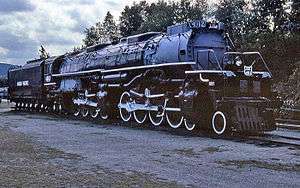
"Big Boy", a 4-8-8-4 type locomotive built by American Locomotive Company in November 1941, is among the world's largest steam locomotives and weighs 1,250,000 pounds (570,000 kg). The Steamtown Special History Study recommended that it remain at Steamtown as it is the only articulated type in the collection. It also recommended that it remain on static display, as it was doubtful that the "track, switches, culverts, trestles, bridges, wyes, turntables, and other facilities that would have to carry her [could] bear her great weight". In fact, since the Steamtown turntable and roundhouse were inadequate for its size,[40] Big Boy has remained out-of-doors since its arrival at Scranton, where it is still on display as of May 2015.[30]
Meadow River Lumber Company No. 1
While at Steamtown, the Shay locomotive endured extensive damage when the building it was stored in collapsed under heavy snow in February 1982. The Shay's wooden cab was destroyed, but "its sand dome, its headlight, its front number plate, its bell and bell hanger, whistle, and other components" were missing before this incident. It was determined that it would remain at the National Historic Site as it was the only Shay and the only geared locomotive in the collection.[17]
Bevier & Southern Railroad No. 109
Bevier & Southern Railroad No. 109 was built by Brooks in 1900. This 2-6-0 type locomotive served the Illinois Central Railroad under several numbers: 560, 3706 and 3719. As of July 2010 it is located at the Illinois Railroad Museum in Union and referred to as Illinois Central 3719.[41]
Illinois Central No. 790
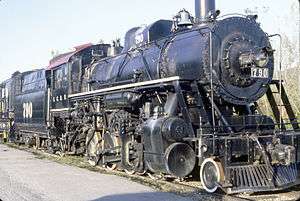
This locomotive was built in 1903 by American Locomotive Company as a 2-8-0 Consolidation type. It was originally owned by Chicago Union Transfer Railway and numbered 100. It was sold to Illinois Central Railroad Company in 1904 and renumbered 641. The railroad, which dated back to 1851, operated 4,265 miles of track between Chicago, Illinois and New Orleans, Louisiana. This locomotive pulled heavy freight in Tennessee and "must have seen hard service, for reportedly the Illinois Central rebuilt it in 1918, modernizing it with a superheater, and possibly replacing the boiler and firebox".[42]
In 1943 it was renumber 790 and remained in service until it was replaced by diesel-electric locomotives and put into storage, "the railroad nevertheless had to fire No. 790 up in the spring to assist Illinois Central trains through track inundated by flood waters near Cedar Rapids, because diesel-electric locomotives with their electric motors shorted out in any water, whereas even the bottom of the firebox in a steam locomotive was much higher above the rail, hence above flood waters."[42] It was sold to Louis S. Keller of Cedar Rapids, Iowa, in 1959 who had hoped to use it for excursions. It was used for "flood duty" in April 1965 at the Clinton Corn Processing Company "where it plowed through overflow from the Mississippi River."[42] Later that year it was sold to David de Camp who planned to use it in the area of Lake Placid, New York. The plans were not met and it was sold to F. Nelson Blount in January 1966.[42]
The only surviving locomotive of the Chicago Union Transfer Railway, No. 790 is the only Illinois Central 2-8-0 Consolidation type of its class to survive. "About 146 standard gauge 2-8-0s survive in the United States, including Illinois Central No. 790".[42] The Steamtown National Historic Site retained this locomotive on the suggestion of the Steamtown Special History Study.[42]
Brooks-Scanlon Corporation No. 1
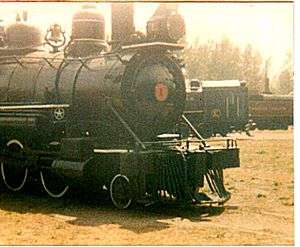
No. 1 was once part of the Steamtown, U.S.A. collection. This type of locomotive was originally developed for use on the flat terrain of the prairie, such as the Great Plains of Kansas and surrounding states, and thus it was referred to as a Prairie-type locomotive. The Prairie locomotives were later used by lumber companies which operated on flat forest terrain. This locomotive was built specifically for the lumber industry and served several lumber firms in Florida[43]
The Carpenter-O'Brien Lumber Company was incorporated in Delaware in 1913. The company, which operated in Florida, ordered this locomotive from Baldwin Locomotive Works, which completed it in 1914. Locomotive No. 1 was put into service at the company's Eastport sawmill in Florida. The locomotive, which could burn either coal or wood, was likely originally outfitted with a Rushton, or cabbage cinder catching stack. "If so, a later owner apparently replaced the Rushton stack with the 'shotgun' stack now on the locomotive."[43]
After the United States entered World War I in 1917, the Carpenter-O'Brien Lumber Company was sold to Brooks-Scanlon Corporation. By 1928, Brooks-Scanlon was operating in four Florida counties and producing 100,000,000 board feet (200,000 m3) of lumber. This locomotive was probably used to haul logs into the mill from the woods or to switch the yard around the Eastport plant, or both. In the following years the locomotive changed hands four of five times between several interconnected Florida lumber firms.[43]
In 1959, locomotive No.1 was taken out of service by its then owner, Lee Tidewater Cypress, in Perry, Florida. It was sold to F. Nelson Blount in 1962 by the Lee Tidewater Cypress parent company, J.C. Turner Company. It was moved to Walpole, New Hampshire and then, across the Connecticut River, to Bellows Falls, Vermont where it stayed until the Blount collection was relocated to Scranton, Pennsylvania.[43]
Simons Wrecking Company No. 2
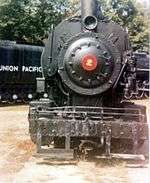
Simons Wrecking Company No. 2 is a H.K. Porter, 0-6-0T steam engine built in 1941. The tank engine, which is oil fired, worked for the US Navy during World War II in Virginia as #14. Later the engine was put into service with Simons Wrecking Co. as No. 2.[44]
Once part of Blount's Steamtown collection, Locomotive #2 was sold before Steamtown moved to Scranton, and languished for many years in an auto salvage yard in Newbury, Massachusetts. In 2006, the engine was removed from the junkyard by Peabody, Massachusetts Public Works Director Dick Carnevale, and restoration began in hopes for it to be displayed in a city park in Peabody.[44] The restoration of the engine was done by Carnevale personally, along with some volunteers. After he resigned in October 2008, the city gave him 60 days to remove the engine from city property. Local residents contacted the Friends of Valley Railroad in Essex, Connecticut, who purchased the engine from Carnevale and transported it to Connecticut where, as of July 2010, the locomotive is undergoing cosmetic restoration and will be displayed at Essex Steam Train and Riverboat.[44]
Canadian National Railways No. 1551
.jpg)
No. 1551 is a 4-6-0 type locomotive, was built by Montreal Locomotive Works, March 1912, and originally was numbered 1354 for the Canadian Northern Railway. Used primarily on Canadian commuter lines, the locomotive was renumbered 1551 in October 1956 and retired in 1958. Blount bought the engine and restoration was begun, but never completed. In 1986, Jerry Joe Jacobson traded a 1929 Baldwin Locomotive Works built shop switcher, Iron and Steel Company No. 3, 0-6-0, for No. 1551. It was restored and ran excursions for the Ohio Central Railroad until Jacobson lost control of the railroad. Jacobson still owns the locomotive. It is stored at Jacobson's "Age of Steam Roundhouse" in Ohio and remains operational.[45]
Canadian National Railways No. 96
.jpg)
Canadian National Railways No. 96, 2-6-0 Mogul type, is also owned by Jerry Joe Jacobson. It was built in 1910 by the Canadian Locomotive Company and originally numbered 1024 for the Grand Trunk Railway, then 926 when Canadian National obtained it in a merger in 1923, CN renumbered it 96 in 1951. While owned by Blount, the locomotive was used for its parts. It was sold in the 1980s and went to Ontario. It was purchased by Jacobson in 1994 and as of 2009 is stored out of service.[46]
Southern Railway No. 926; Repton
.jpg)
No. 926 is a Schools class 4-4-0 type locomotive, one of 40 named after British public schools.[47] It is one of three Schools class locomotives to survive the onset of diesel power. It was completed in May 1934 and entered service on the Bournemouth route, with some time operating between Waterloo and Portsmouth before that line was electrified. It was one of the last of the class to be overhauled by British Railways in 1960, so was considered a good choice for preservation. In December 1963 the engine was withdrawn from service, and in 1966 it was purchased and overhauled at Eastleigh Works, before moving to America. It was donated by the purchaser to Steamtown. Steamtown loaned the engine to the Cape Breton Steam Railway in Canada, where it operated a regular passenger service. In 1989, it was sold again, and returned to the United Kingdom to the North Yorkshire Moors Railway (NYMR), where it was again overhauled and found to be in good condition.[48] As of March 2012, the locomotive is awaiting boiler repair and a possible overhaul at NYMR.[49]
Canadian Pacific Railway Locomotive No. 2816
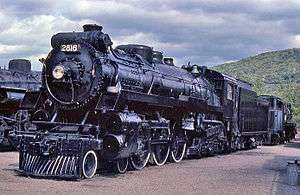
Canadian Pacific Railway Locomotive No. 2816 was acquired by Blount in January 1964. It was built by Montreal Locomotive Works in 1930.[50][51] The 4-6-4 Hudson, H1b class locomotive had logged over 2,000,000 miles (3,200,000 km) in 30 years of service pulling passenger trains between Winnipeg and Calgary, and Winnipeg and Fort William, Ontario. Later, 2816 served on the Windsor-to-Quebec City corridor. The locomotive's final run was on May 26, 1960, pulling a Montreal–Rigaud commuter train.[52] The Steamtown Special History Study recommended that the locomotive be kept in the collection, as it was the only 4-6-4 in the group,[50] but the National Park Service sold it back to Canadian Pacific Railway, who restored it and put it back into service.[52]
In 1998, the Steamtown National Historic Site, which is funded by the federal government, began divesting itself of foreign equipment, including CPR 2816. Canadian Pacific Railway acquired it and undertook a 3-year, 1 million dollar restoration which included converting it from coal-burning to oil.[53] In 2001, renamed the "Empress", 2816 was used for pricy excursions between Calgary and Vancouver, British Columbia. After taking a year off in 2009, the Empress went on tour in 2010 offering rides to the general public across Canada. CPR donated the ticket proceeds to the Children's Wish Foundation.[54]
Bullard Company No. 2
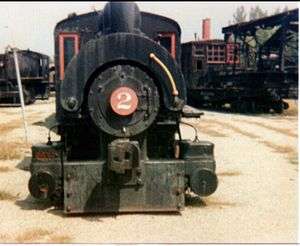
Bullard Company No. 2 is a small tank locomotive built by H.K. Porter Company for the Bullard Company, October 1937. It is on display at Steamtown National Historic Site, as of September 2010. According to the Steamtown Special History Study, this locomotive was used to switched cars around the Bullard tool plant in Bridgeport, Connecticut, for about 15 or 20 years before acquisition by Steamtown. The Bullard Company sold it to a used locomotive dealer, the American Machinery Corporation of Bridgeport, Connecticut, probably in the late 1950s or early 1960s. It was purchased by Blount in June 1963. The SSHS also said that a catalog, believed to be the one the Bullard Company used to order the locomotive, was in the possession of the SNHS at the time the report was written.[55]
Union Pacific Railway No. 737
Union Pacific No. 737, a 4-4-0 "American", was built by Baldwin Locomotive Works in 1887. The oldest locomotive in the collection to have operated in the United States, it is the "oldest genuine Union Pacific in existence and the only Union Pacific 4-4-0 in existence".[56] At the time it was built it was the most common type of locomotive used for both passenger and freight trains in the United States and was therefore referred to as the "American Standard" or "American". In 1904 the locomotive was sold to the Southern Pacific Company where its number was changed to 246 and then to 216. It was retired from service on mainline railroads and put to use in industry in 1929. The locomotive operated as 216 for the Erath Sugar Company and the Vermillion Sugar Company. It was retired by the latter company in 1956 and acquired by Blount in 1957.[56]

Originally the locomotive had a "diamond" smoke stack. It is unknown when that was changed to a straight "shotgun" stack. Sometime during the early 20th century the locomotive was converted from coal burning to oil burning and its wooden "cowcatcher" pilot was replaced with a steel pipe pilot. The wooden cab was replaced with an all-steel cab, and its kerosene "box" headlamp was replaced with an electric one. When the engine was relocated from Louisiana to Vermont its steel cab roof was removed in preparation for the ride on a flat car. The roof was later mistaken for scrap metal as a worker at Steamtown cut out a piece for use as a stack cover for the locomotive. In 1970 the train underwent what the Steamtown Historical Study refers to as a "misguided" restoration, and given a diamond-shaped smoke stack and a kerosene "box" headlamp, both of which bearing very little resemblance to the stack and headlamp originally worn by the engine. The restoration thus gave the engine an appearance unlike any form it had assumed during its service life.[56]
The engine was removed from the Steamtown collection in 1995 and was moved to the Nevada Southern Railroad Museum at Boulder City, Nevada. The NSRM then loaned (and later transferred ownership to) the Western Pacific Railroad Museum in Portola, California.
In 2004, the Western Pacific Railroad Museum traded the 737 to the Double T Ranch in Stevinson, California. The Double T has cosmetically restored the engine to its 1914(SP#216) appearance, and placed it on display along with some antique passenger cars. This exhibit was dubbed as the "History Train", and offers "excursion rides". During these excursions, the train does not actually move, but sounds and motions that simulate a train ride are produced to create an illusion that the train is in motion.[57]
References
- 1 2 Sawyer, Mina Titus (February 1, 1964). "Maine's 'Iron Horses' Head For Their Last Dramatic Round-up". Lewiston Evening Journal. p. 1A. Retrieved March 18, 2012.
- ↑ "Railroads That Go Nowhere Really Getting Somewhere". Reading Eagle. December 25, 1961. p. 33. Retrieved March 13, 2012.
- ↑ "Steamtown Out of Steam". Nashua Telegraph. February 15, 1963. p. 2. Retrieved March 13, 2012.
- ↑ "Millionaire Dies in Plane Crash". The Milwaukee Journal. September 1, 1967. p. 2. Retrieved March 13, 2012.
- ↑ Shaughnessy, Jim (1997). The Rutland Road. Syracuse University Press. pp. 213–214. ISBN 0815604564.
- ↑ "Obituaries: Robert "Bob" W. Adams". The Commons Online. Vermont Independent Media. Retrieved March 13, 2012.
- 1 2 3 4 Rice, Bill (September 3, 1977). "A Great Way to see the Colors". Schenectady Gazette. p. 30. Retrieved March 13, 2012.
- ↑ "Steam Railroad Gets Extension". Bangor Daily News. November 19, 1971. p. 5. Retrieved March 13, 2012.
- ↑ Colin, Stewart (March 7, 1974). "The Past is the Future". Beaver County Times. p. 15. Retrieved March 13, 2012.
- ↑ "Steamtown Seeks Increased Control Over Tracks". Lewiston Daily News. October 5, 1976. p. 10. Retrieved March 13, 2012.
- ↑ Winn, Sherry (August 8, 1978). "Steamtown Looking for a New Home". Sarasota Herald-Tribrune. p. 3B. Retrieved March 13, 2012.
- ↑ "Steamtown Chair Charges Incompetence". Nashua Telegraph. October 14, 1980. p. 10. Retrieved March 13, 2012.
- 1 2 3 4 5 McManus, Michael (March 29, 1982). "How Would Your Community Like a Big Tourist Attraction?". Bangor Daily News. p. 14. Retrieved March 13, 2012.
- ↑ "Steam Railroad Museum Moving Down Tracks". Wilmington Morning Star. August 11, 1983. p. 3C. Retrieved March 13, 2012.
- 1 2 McManus, Michael (June 14, 1983). "Three Proposals That Didn't Die". Schenectady Gazette. p. 28. Retrieved March 13, 2012.
- 1 2 3 4 Chappell, Gordon. "Canadian Pacific 1293". Steam Over Scranton: Special History Study, American Steam Locomotives. National Park Service. Retrieved March 13, 2012.
- 1 2 Chappell, Gordon. "Meadow River Lumber Company No. 1". Steam Over Scranton: Special History Study, American Steam Locomotives. National Park Service. Retrieved March 13, 2012.
- 1 2 3 Van Gelder, Lawrence (September 25, 1983). "Steamtown's Autumn Outing is a Farewell". nyt.com. The New York Times. Retrieved March 18, 2012.
- ↑ "Rail Museum on Track to New Home". Reading Eagle. December 26, 1983. p. 6. Retrieved March 12, 2012.
- ↑ Roddy, Michael (January 7, 1983). "Scranton is Converting Railroad Station Into Hotel". Pittsburgh Post-Gazette. p. 3. Retrieved March 13, 2012.
- 1 2 Smith, John W. (December 26, 1983). "Rail Run out of Steam". Reading Eagle. p. 5. Retrieved March 13, 2012.
- ↑ Barcousky, Len (July 3, 1994). "Federal Train Park Steams Both Sides". Pittsburgh Post-Gazette. p. B1.
- 1 2 3 "Getting Burned by Steamtown". Reading Eagle. July 2, 1995. p. A16. Retrieved March 13, 2012.
- ↑ Flannery, Joseph (October 2, 1987). "The Junkyard on the Mountainside". Pittsburgh Post-Gazette. p. 9. Retrieved March 13, 2012.
- ↑ "House Approves Spending for Scranton Steamtown". The Pittsburgh Press. October 16, 1986. p. B5. Retrieved March 13, 2012.
- ↑ Chapell, Gordon. Steam Over Scranton: The Locomotives of Steamtown. Special History Study, American Steam Locomotives: Introduction National Park Service. 1991. Accessed July 14, 2010
- 1 2 3 4 5 Chappell, Gordon. "Rahway Valley Railroad No.15". Steam Over Scranton: Special History Study, American Steam Locomotives. National Park Service. Retrieved March 13, 2012.
- 1 2 Railfan & Railroad, Volume 23. Carstens Publications. 2004. pp. 9–14.
- 1 2 Solomon, Brian (2008). Railroads of Pennsylvania: Your Guide To Pennsylvania's Historic Trains and Railway Sites. Voyageur Press. pp. 39–45. ISBN 0-7603-3245-2.
- 1 2 "Steamtown's Locomotives and Cars". Steamtown National Historic Site. National Park Service. Retrieved March 13, 2012.
- ↑ Elwell (November 7, 1979). "Old No. 1293 Puffs Its Way Into Film.". Montreal Gazette. p. 1. Retrieved March 13, 2012.
- ↑ Reid, John (July 2, 1976). "The Storybook Comes Alive: The Steam Train is Back Again". Lewiston Evening Journal. p. 6. Retrieved March 13, 2012.
- 1 2 "CP 1293 – Ex Canadian Pacific 4-6-2 No. 1293". Age of Steam Roundhouse. Age of Steam, Ltd. Archived from the original on March 9, 2012. Retrieved March 13, 2012.
- 1 2 Lahmers, Ken (October 5, 2008). "Kaleidoscope: Steaming through the Cuyahoga Valley". Hudson Times. p. 6. Archived from the original on March 6, 2012. Retrieved March 13, 2012.
- ↑ "Age of Steam Roundhouse Report – Fall 2011". Age of Steam. Age of Steam, Ltd. Retrieved March 17, 2012.
- 1 2 "CP 1278 – Ex Canadian Pacific 4-8-2 No. 1278". Age of Steam Roundhouse. Age of Steam Roundhouse, Ltd. Archived from the original on March 23, 2012. Retrieved March 12, 2012.
- 1 2 Roth, Jeffery B. (June 19, 1995). "Man Critical After Train Explosion". Gettysburg Times. p. 1A. Retrieved March 13, 2012.
- 1 2 Holt (November 12, 1996). "Gettysburg Mishap 'Could Have Been as Catastrophic as TWA Flight 800'". Gettysburg Times. p. 1A. Retrieved March 13, 2012.
- 1 2 "Canadian Pacific 1246". News From the Naugy: Occasional News of the Railroad Museum of New England. The Railroad Museum of New England. Retrieved March 13, 2012.
- ↑ Chappell, Gordon. "Union Pacific No. 4012". Steam Over Scranton: Special History Study, American Steam Locomotives. National Park Service. Retrieved March 13, 2012.
- ↑ Illinois Railroad Museum Accessed July 15, 2010
- 1 2 3 4 5 6 Chappell, Gordon. "Illinois Central Railroad No. 790". Steam Over Scranton: Special History Study, American Steam Locomotives. National Park Service. Retrieved March 15, 2012.
- 1 2 3 4 Chappell, Gordon. "Brooks-Scanlon Corporation No. 1". Steam Over Scranton: Special History Study, American Steam Locomotives. National Park Service. Retrieved March 14, 2012.
- 1 2 3 Roy, Matthew K. (December 30, 2008). "A Peabody Train Has New Home". salemnews.com. The Salem News. Retrieved March 18, 2012.
- ↑ "CN 1551 – Ex Canadian Northern 4-6-0 No. 1551". Age of Steam Roundhouse. Age of Steam, Ltd. Retrieved March 14, 2012.
- ↑ "GTW 96 – Ex Grand Trunk Railway 2-6-0 No. 96". Age of Steam Roundhouse. Age of Steam, Ltd. Retrieved March 14, 2012.
- ↑ Swift, Peter (2007). Maunsell 4-4-0 Schools Class (Locomotives in Detail series volume 6). Ian Allan Publishing. p. 78. ISBN 0-7110-3178-9.
- ↑ Herring, Peter (2000). Classic British Steam Locomotives. Abbeydale Press. pp. 124–135. ISBN 1-86147-057-6.
- ↑ "NYHM: Restoration". www.nymr.co.uk. The North Yorkshire Moors Railway. Retrieved March 15, 2012.
- 1 2 Chappell, Gordon. "Canadian Pacific No, 2816". Steam Over Scranton: Special History Study, American Steam Locomotives. National Park Service. Retrieved March 14, 2012.
- ↑ Chapell, Gordon. Steam Over Scranton: The Locomotives of Steamtown. Special History Study, American Steam Locomotives: Canadian Pacific Railway No.2816, National Park Service, 1991. Accessed July 13, 2010
- 1 2 "Canadian Pacific Railway Steam Program : Empress". Canadian Pacific Railway Steam Program. CPRSteam.com. Retrieved March 12, 2012.
- ↑ Nolan, Dan (June 7, 2003). "Dan. Vintage Locomotive Chugs Into City on Monday". The Spectator. p. 9.
- ↑ "Canadian Pacific heritage train rides raise $50,000 for the Children's Wish Foundation of Canada". Canadian Pacific Railway. Retrieved March 12, 2012.
- ↑ Chappell, Gordon. "Bullard Company No. 2". Steam Over Scranton: Special History Study, American Steam Locomotives. National Park Service. Retrieved March 14, 2012.
- 1 2 3 Chappell, Gordon. "Union Pacific No.737". Steam Over Scranton: Special History Study, American Steam Locomotives. National Park Service. Retrieved March 12, 2012.
- ↑ Yancey, Kim. "Antique train takes passengers on a trip through time". Los Banos Enterprise. Los Banos Enterprise, A subsidiary of The McClatchy Company. Retrieved March 14, 2012.
External links
| Wikimedia Commons has media related to Steamtown, U.S.A.. |
- Northeast Rails photos from the Steamtown, U.S.A. collection from several photographers
- Rail Fans Surviving Steam Locomotives
- Steam Locomotive dot Com Surviving Steam Locomotives
- Green Mountain Railroad
- The Lost Engines of Roanoke: Other Lost Trains
- Winterail 2011 (Union Pacific 216 Photos)
- American Rails
- Steamtown, Bellows Falls
- Surviving Steam Locomotives
- Pictorial visit to Steamtown in 1978
- Repton Schools Class No. 926 Returned to UK from Steamtown (Photos)
- Old Time Trains
- Index of photographs taken by Don Ball, Jr.
